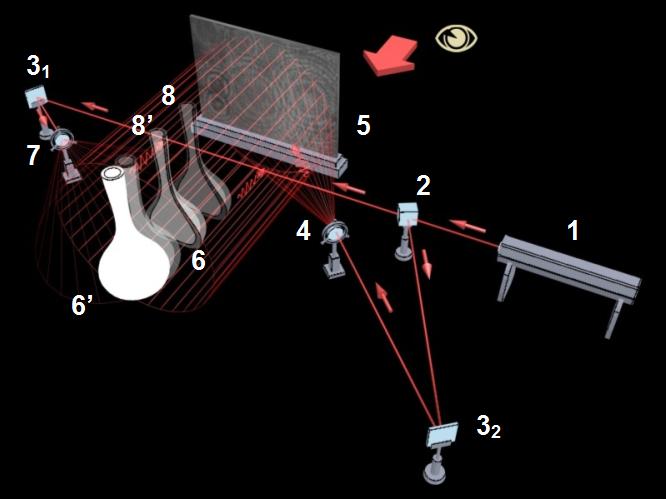Real-Time_Method
3.1.2.2 Real-Time Method
The real-time method of holographic interferometry is based on the principle that time interval Δt expired between the interfering wavefronts is possible to change arbitrarily in relation to the way of loading of the investigated object and the characteristics of the arizing interference field.
This method is sometimes called the method of "living fringes". The changes of interference image are observable at the time when they really are in progress.
We expose the object on a hologram that is later photochemically processed and inserted into the same location where it was exposed. If afterwards the deformation of the object occurs by the influence of external loading then the interference occurs between the object wave created by reflection of the object beam from the object and the object wave created by reconstruction of the hologram through the reference beam. The observer watching the virtual image of the object sees the interference fringes created by interference of both waves that move under the influence of the object deformation.
The advantage of this method lies mainly in the fact that interference fringes offer immediate information about the size and the shape of the object deformation. It means that the interference image is the time function of the external loading process. This method requires that the position of the hologram, the position of the optical components and the position of the object in the holographic experimental order be constant during the whole experiment, and that the fine interference structure recorded on the hologram be identified with the interference structure arising in real time with the accuracy of 1/8–1/10 of the interference fringe width (Saxby, 1988).

1 – laser, 2 – beam splitter, 31 , 2 – mirrors, 4 – objective, 5 – hologram,
6 – reconstructed image of the object, 6’ – immediate state of object,
7 – diverging lens, 8 – wave reflected from the object 6,
8‘ – wave reflected from the object 6‘
The complex amplitude of the object wave, reconstructed by the hologram can be expressed as follows:
 ,(3.10)
,(3.10)
and the associated wave:
 ,(3.10a)
,(3.10a)
and the complex amplitude of the object wave that is dispersed by the object at time t can be expressed as follows:
 ,(3.11)
,(3.11)
where
![]() expresses the change of phase in consequence of the object
deformation.
expresses the change of phase in consequence of the object
deformation.
The complex amplitude of the reconstructed wave contains negative sign expressing the fact, that the hologram represents holographic negative. The negative sign corresponds with constant time shift π for the whole hologram.
The associated wave can be expressed as follows:
 ,(3.11a)
,(3.11a)
In real-time holographic interferometry the intensity of illumination is equated as follows:
 (3.12)
(3.12)
and after modification it takes the form:
 ,(3.13)
,(3.13)
This expression
represents the intensity of the object illumination characterised by
the original object wave remodulated by the bright and dark
interference fringes equivalent to expression  .
.
The real-time method requires redistribution of the intensities of both the object and the reference beams to reach maximal contrast between the arising fringes. The intensities and polarisations of the waves must be equal. As we think of the wave reflected from a real object, the reconstructed wave tends to be several times weaker than the wave from the real object. To equalise their intensities we must change the laser beam division ratio so that the object wave intensity decreases in proportion as the intensity of the reconstructed wave increases. For this purpose, either a continual light beam splitter or a beam splitter with graded permeability can be used.
Recording in real time has the following advantages (Balaš, Szabó, 1986):
It enables us to observe the time development of the interference image and to record various stages of object changes by one hologram of the initial state.
It simplifies the process of assigning of absolute orders to the interference lines by making it possible to determine the direction of rising (displacements) of their parameters as well as the line of zero order.
It enables us to investigate the dynamic processes and their recording by a video camera.
The disadvantage of this method is the necessity of special technical equipment to develop the hologram in its original place or its exact setting into its original position as well as the need for recording materials with insignificant dimensional changes during their chemical processing and drying.


